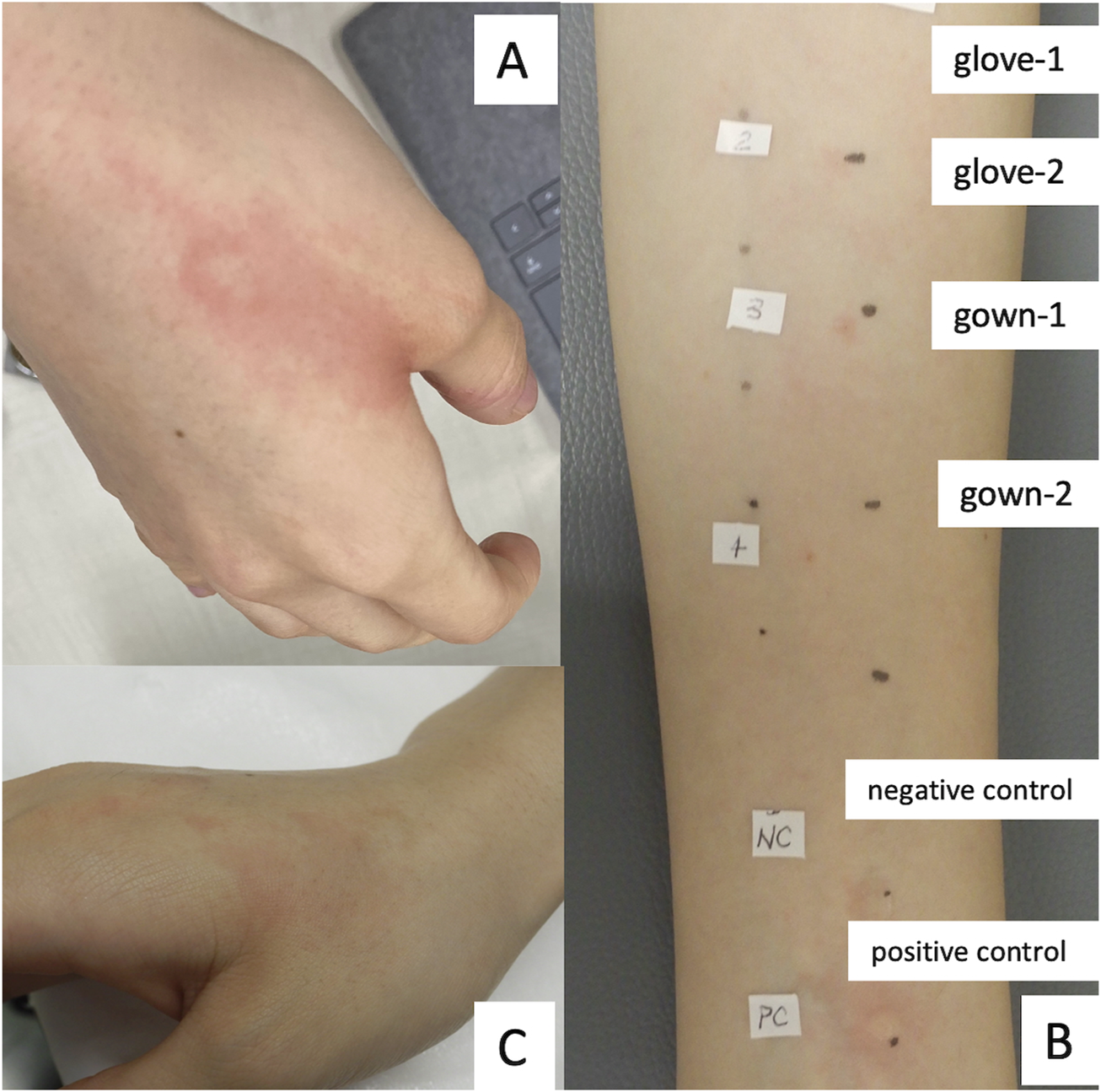Dear Editors,
We report a case of contact urticaria from medical supplies. A-22-year-old woman, midwife school student, developed pruritic rash on sites in contact with some gowns or gloves during practical trainings. Lesions appeared immediately after wearing gowns or gloves, and disappeared within several minutes. Physical examination revealed wheal on edematous erythema on dorsal aspect of right hand (Figure 1A). We diagnosed contact urticaria to medical supplies on the basis of morphology and history. The white blood cell count and serum IgE level were 5,560/μL and 64 IU/mL, and antigens specific IgE were detected only to banana (0.42 IU/mL, class 1) and not to others including latex.
FIGURE 1

(A) Wheal and edematous erythema on dorsal aspect of right hand. (B) Results of prick testing: positive reactions to glove-2, gown-1, and histamine chlorhydrate solution, and negative ones to others. (C) Erythematous lesions occurred immediately after wearing glove-1.
Prick testing was performed with 4 solutions from two gloves and two gowns she used (after cutting 1 g of them into 1 cm square pieces, placed in saline for 1 hour), positive control (histamine chlorohydrate solution, 10 mg/mL) and negative control (saline). She had developed rash to 4 items, but not always. Those droplets were wiped off with soft paper tissue, and reading performed after 15 min [1]. We noted positive reactions to glove-2 (2.3 mm wheal in diameter), gown-1 (2.9 mm wheal in diameter) and histamine chlorhydrate solution (3.9 mm wheal in diameter), and negative ones to others (Figure 1B). Cutaneous lesions were prevented by taking 20 mg of bilastine, an antihistamine drug.
As allergic contact urticaria to medical supplies, cases due to polypropylene were reported [2, 3]. Since it was a common component of the gloves and gowns, we speculated that it was the causative agent in our case initially. However, it and other common components were not detected in glove-2 and gown-1 by component analysis and dissolution test. Although dibutyl phosphate were detected in gown-1 and 2, it was unlikely to cause allergic reactions. After these results were obtained, we performed challenge test with glove-1 if it can be used in the future. The patient developed pruritic rash immediately after wearing it despite negative at the prick testing (Figure 1C). Although we had to be careful for the cause in this case considering the patient’s occupation, it was not identified. Therefore, we finally diagnosed our case as non-immunological contact urticaria to medical supplies; lesions were always localized without systemic reactions, and occurred within a few minutes. Although pathology of positive reactions to glove-2 and gown-1 in the prick testing were unclear, we suspect that physical urticaria-like reaction may act in the mechanism of pathology [4].
Statements
Data availability statement
The original contributions presented in the study are included in the article/supplementary material, further inquiries can be directed to the corresponding author.
Ethics statement
Written informed consent was obtained from the individual(s) for the publication of any potentially identifiable images or data included in this article and it was recorded it in the medical record.
Author contributions
EH and TO drafted the manuscript. All authors contributed to the article and approved the submitted version.
Funding
The author(s) declare that no financial support was received for the research and/or publication of this article.
Acknowledgments
We gratefully acknowledge the help of Prof. Howard I. Maibach, MD.
Conflict of interest
The authors declare that the research was conducted in the absence of any commercial or financial relationships that could be construed as a potential conflict of interest.
Generative AI statement
The author(s) declare that no Generative AI was used in the creation of this manuscript.
References
1.
Lachapelle J Maibach H . Methodology of open (non-prick) testing, prick testing, and its variants. In: LachapelleJMaibachH, editors. Patch testing and prick testing. 4th ed. Berlin: Springer (2020). p. 177–91.
2.
Corazza M Bencivelli D Zedde P Monti A Zampino MR Borghi A . Severe contact urticaria, mimicking allergic contact dermatitis, due to a surgical mask worn during the COVID-19 pandemic. Contact Dermatitis (2021) 84(6):466–7. 10.1111/cod.13768
3.
Goller M Dickel H Nicolay JP . A case of immediate-type allergy from polypropylene in a particle filter mask in a nurse. Contact Dermatitis (2022) 87(3):294–6. 10.1111/cod.14143
4.
McSweeney SM Christou EAA Maurer M Grattan CE Tziotzios C McGrath JA . Physical urticaria: clinical features, pathogenesis, diagnostic work-up, and management. J Am Acad Dermatol (2023) 89(2):324–37. 10.1016/j.jaad.2023.02.062
Summary
Keywords
contact urticaria, prick testing, medical gowns, gloves, physical urticaria
Citation
Hashimoto E, Okusa T, Hamamoto T, Ito Y, Ikarashi Y and Nakada T (2025) Contact urticaria from medical gowns and gloves in a midwife student. J. Cutan. Immunol. Allergy 8:14731. doi: 10.3389/jcia.2025.14731
Received
07 April 2025
Accepted
28 May 2025
Published
09 June 2025
Volume
8 - 2025
Updates
Copyright
© 2025 Hashimoto, Okusa, Hamamoto, Ito, Ikarashi and Nakada.
This is an open-access article distributed under the terms of the Creative Commons Attribution License (CC BY). The use, distribution or reproduction in other forums is permitted, provided the original author(s) and the copyright owner(s) are credited and that the original publication in this journal is cited, in accordance with accepted academic practice. No use, distribution or reproduction is permitted which does not comply with these terms.
*Correspondence: Tokio Nakada, tokio@med.showa-u.ac.jp
ORCID: Yoshiaki Ikarashi, orcid.org/0000-0001-7270-5382
Disclaimer
All claims expressed in this article are solely those of the authors and do not necessarily represent those of their affiliated organizations, or those of the publisher, the editors and the reviewers. Any product that may be evaluated in this article or claim that may be made by its manufacturer is not guaranteed or endorsed by the publisher.